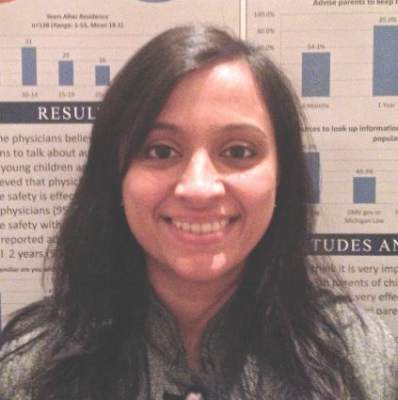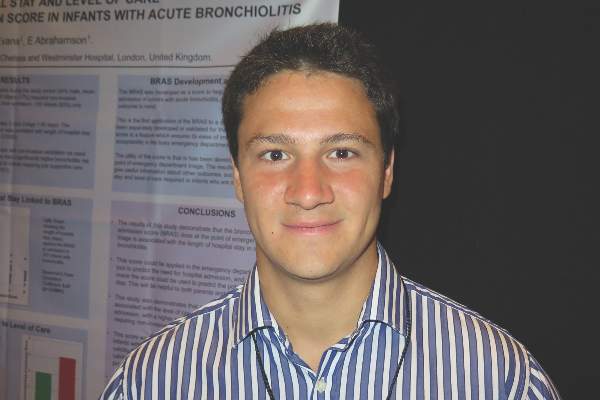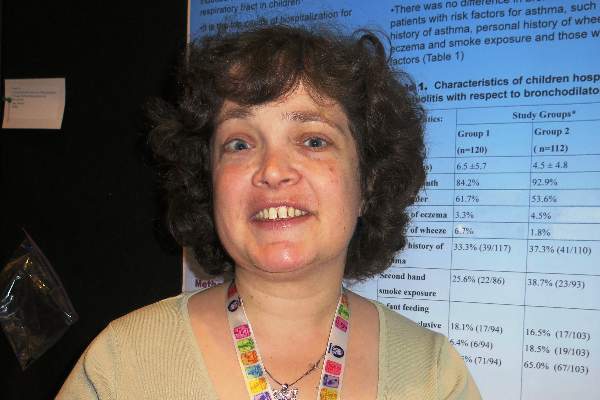User login
American Academy of Pediatrics (AAP): 2014 National Conference and Exhibition
Pediatricians recommend rear-facing car seats, but parents don’t always comply
SAN DIEGO – Three years after the American Academy of Pediatrics recommended that children ride in rear-facing car seats until 2 years of age, almost 90% of pediatricians in Michigan were in compliance, an electronic survey found.
The study, the first of its type in Michigan, highlights “effective messaging, dissemination, and uptake of AAP guidelines,” reported lead researcher Dr. Sneha Rao of Hurley Medical Center, Flint, Mich., and her associates.
In 2011, the AAP upped its age recommendation for use of rear-facing car seats from 12 months (or 20 pounds of body weight) to 2 years of age (Pediatrics 2011;127:788-93), Dr. Rao noted. “Scientifically, the reason for the change is the reduction in impact,” she said in an interview at the annual meeting of the AAP. “It’s easier to treat a broken leg than a broken neck.”
Research shows rear-facing car seats are safer than front-facing seats for young children, including in side-on collisions. In one study, children under 24 months old who were seriously injured in side-on crashes were five times more likely to have been in a front-facing than a rear-facing seat (odds ratio, 5.53; 95% confidence interval, 3.74-8.18) (Inj. Prev. 2007;13:398-402). Side-on collisions often have a frontal component, which causes the child’s head to move further into the seat if rear facing, but away from the seat if front facing, the researchers said.Michigan and many other states also recommend or require that children ride in rear-facing safety seats until about age 2 years. But parents do not necessarily follow the recommendation, studies indicate. Earlier this year, authors of a direct-observation study carried out in Indiana reported that only about 60% of infants and toddlers up to 2 years old rode in rear-facing seats (Inj. Prev. 2014;20:226-31). And in Michigan, another direct-observation study found that 20%-25% of children were riding in a type of seat meant for an older child. Dr. Rao and associates found that only 39% of clinicians thought it was “very effective” to counsel parents of young children about automobile safety, although 73%-82% reported “always” doing so with newborns up to age 2 years, the researchers reported.
For their study, Dr. Rao and her associates sent an electronic survey to all pediatric care providers listed in the directory of the Michigan chapter of the AAP. The 146 respondents included pediatricians and generalists who mostly worked in outpatient settings, the investigators reported. More than 95% of physicians surveyed said they discussed automobile safety with parents of infants and toddlers, Dr. Rao and associates reported. Among 134 respondents to the question about rear-facing seats, 89.6% said they counseled parents to keep children in rear-facing seats until at least 2 years of age, the researchers found.
The AAP guidelines call for 2-year-olds to switch to a front-facing safety seat in the back seat. From ages 4-8 years, they are to use a booster seat and a safety belt. Older children should use lap and shoulder belts and should not ride in the front seat until at least age 13 years, the guidelines state.
The survey’s response rate was only 20%, and questions were not worded so that age categories were necessarily interpreted as mutually exclusive, Dr. Rao acknowledged. She reported no external funding sources of conflicts of interest.
SAN DIEGO – Three years after the American Academy of Pediatrics recommended that children ride in rear-facing car seats until 2 years of age, almost 90% of pediatricians in Michigan were in compliance, an electronic survey found.
The study, the first of its type in Michigan, highlights “effective messaging, dissemination, and uptake of AAP guidelines,” reported lead researcher Dr. Sneha Rao of Hurley Medical Center, Flint, Mich., and her associates.
In 2011, the AAP upped its age recommendation for use of rear-facing car seats from 12 months (or 20 pounds of body weight) to 2 years of age (Pediatrics 2011;127:788-93), Dr. Rao noted. “Scientifically, the reason for the change is the reduction in impact,” she said in an interview at the annual meeting of the AAP. “It’s easier to treat a broken leg than a broken neck.”
Research shows rear-facing car seats are safer than front-facing seats for young children, including in side-on collisions. In one study, children under 24 months old who were seriously injured in side-on crashes were five times more likely to have been in a front-facing than a rear-facing seat (odds ratio, 5.53; 95% confidence interval, 3.74-8.18) (Inj. Prev. 2007;13:398-402). Side-on collisions often have a frontal component, which causes the child’s head to move further into the seat if rear facing, but away from the seat if front facing, the researchers said.Michigan and many other states also recommend or require that children ride in rear-facing safety seats until about age 2 years. But parents do not necessarily follow the recommendation, studies indicate. Earlier this year, authors of a direct-observation study carried out in Indiana reported that only about 60% of infants and toddlers up to 2 years old rode in rear-facing seats (Inj. Prev. 2014;20:226-31). And in Michigan, another direct-observation study found that 20%-25% of children were riding in a type of seat meant for an older child. Dr. Rao and associates found that only 39% of clinicians thought it was “very effective” to counsel parents of young children about automobile safety, although 73%-82% reported “always” doing so with newborns up to age 2 years, the researchers reported.
For their study, Dr. Rao and her associates sent an electronic survey to all pediatric care providers listed in the directory of the Michigan chapter of the AAP. The 146 respondents included pediatricians and generalists who mostly worked in outpatient settings, the investigators reported. More than 95% of physicians surveyed said they discussed automobile safety with parents of infants and toddlers, Dr. Rao and associates reported. Among 134 respondents to the question about rear-facing seats, 89.6% said they counseled parents to keep children in rear-facing seats until at least 2 years of age, the researchers found.
The AAP guidelines call for 2-year-olds to switch to a front-facing safety seat in the back seat. From ages 4-8 years, they are to use a booster seat and a safety belt. Older children should use lap and shoulder belts and should not ride in the front seat until at least age 13 years, the guidelines state.
The survey’s response rate was only 20%, and questions were not worded so that age categories were necessarily interpreted as mutually exclusive, Dr. Rao acknowledged. She reported no external funding sources of conflicts of interest.
SAN DIEGO – Three years after the American Academy of Pediatrics recommended that children ride in rear-facing car seats until 2 years of age, almost 90% of pediatricians in Michigan were in compliance, an electronic survey found.
The study, the first of its type in Michigan, highlights “effective messaging, dissemination, and uptake of AAP guidelines,” reported lead researcher Dr. Sneha Rao of Hurley Medical Center, Flint, Mich., and her associates.
In 2011, the AAP upped its age recommendation for use of rear-facing car seats from 12 months (or 20 pounds of body weight) to 2 years of age (Pediatrics 2011;127:788-93), Dr. Rao noted. “Scientifically, the reason for the change is the reduction in impact,” she said in an interview at the annual meeting of the AAP. “It’s easier to treat a broken leg than a broken neck.”
Research shows rear-facing car seats are safer than front-facing seats for young children, including in side-on collisions. In one study, children under 24 months old who were seriously injured in side-on crashes were five times more likely to have been in a front-facing than a rear-facing seat (odds ratio, 5.53; 95% confidence interval, 3.74-8.18) (Inj. Prev. 2007;13:398-402). Side-on collisions often have a frontal component, which causes the child’s head to move further into the seat if rear facing, but away from the seat if front facing, the researchers said.Michigan and many other states also recommend or require that children ride in rear-facing safety seats until about age 2 years. But parents do not necessarily follow the recommendation, studies indicate. Earlier this year, authors of a direct-observation study carried out in Indiana reported that only about 60% of infants and toddlers up to 2 years old rode in rear-facing seats (Inj. Prev. 2014;20:226-31). And in Michigan, another direct-observation study found that 20%-25% of children were riding in a type of seat meant for an older child. Dr. Rao and associates found that only 39% of clinicians thought it was “very effective” to counsel parents of young children about automobile safety, although 73%-82% reported “always” doing so with newborns up to age 2 years, the researchers reported.
For their study, Dr. Rao and her associates sent an electronic survey to all pediatric care providers listed in the directory of the Michigan chapter of the AAP. The 146 respondents included pediatricians and generalists who mostly worked in outpatient settings, the investigators reported. More than 95% of physicians surveyed said they discussed automobile safety with parents of infants and toddlers, Dr. Rao and associates reported. Among 134 respondents to the question about rear-facing seats, 89.6% said they counseled parents to keep children in rear-facing seats until at least 2 years of age, the researchers found.
The AAP guidelines call for 2-year-olds to switch to a front-facing safety seat in the back seat. From ages 4-8 years, they are to use a booster seat and a safety belt. Older children should use lap and shoulder belts and should not ride in the front seat until at least age 13 years, the guidelines state.
The survey’s response rate was only 20%, and questions were not worded so that age categories were necessarily interpreted as mutually exclusive, Dr. Rao acknowledged. She reported no external funding sources of conflicts of interest.
Key clinical point: Most pediatricians surveyed in Michigan said they advised using rear-facing child car seats until children turned 2 years old.
Major finding: Among 134 respondents, 120 (89.6%) said they counseled parents to keep children in rear-facing safety seats at least until age 2 years.
Data source: Electronic survey of pediatricians and general practitioners in Michigan.
Disclosures: Dr. Rao reported no external funding sources of conflicts of interest.
Health care texting is ‘the right format for today’s families’
SAN DIEGO– Dr. Colleen A. Kraft characterizes health care texting as “the right format for today’s families,” because an estimated 91% of young Americans have cell phones and 90% of text messages are read within the first 3 minutes of receiving them.
Text messages “get people’s attention,” she said during a plenary session at the annual meeting of the American Academy of Pediatrics. “They reach a wide audience. Youth text more than their adult counterparts, and low-income Americans text more than higher-income adults.”
One health care–texting program, Text4baby, has become the largest mobile health service in the United States, reaching more than 760,000 moms since it was launched in 2010. Pregnant women and moms with kids under 1 year of age can sign up by texting BABY (or BEBE for the Spanish version) to 511411. Participants receive free health and safety messages three times per week timed to their baby’s due date.
“You also get messages after that until the baby is 1 year old [which] are developmentally appropriate as well,” said Dr. Kraft, who is a member of the content development council for the service. This council creates messages based on the medical literature and comprises representatives from medical organizations including the AAP, the American College of Nurse-Midwives, the American Congress of Obstetricians and Gynecologists, the Centers for Disease Control and Prevention, and the March of Dimes, “a number of people who are very interested in the outcomes of healthy pregnancy,” she said.
Text4baby targets low-income and young women, especially those who identify themselves as Hispanic or African American at higher risk of disproportionately poor birth outcomes. The service addresses critical maternal and child health topics, including safety, development, nutrition, prenatal care, oral health, and preparing for well-baby visits.
“There’s often a very big disconnect with our lower-income families regarding [the notion of] ‘here’s the end of your pregnancy. Now you need to find a pediatrician,’” explained Dr. Kraft, medical director of the Health Network at Cincinnati Children’s Hospital Medical Center. “We find that our upper-income families often will do prenatal visits, but this is not the case with our lower-income families.”
More than half of the messages (58%) contain additional health and resource information and 46% link to mobile Web pages developed in partnership with the AAP and other medical associations. “This is great, because if someone gets a message and they want to find out more about it, they can click a link and be directed to a video or to more information to read,” she said. “There are priority topics, and there’s audience testing so we can see what messages actually resonate with our younger families and with our pregnant moms, because we don’t want to be sending out messages that people aren’t going to read or understand or relate to.”
For example, nine messages prompt mothers to text back LIKE when they find a message helpful, and seven messages encourage mothers to text back MORE to get additional information. Text4baby also features an appointment reminder as a way to improve well-baby and other appointment adherence and immunization rates.
Studies of Text4baby outcomes to date suggest that the service helps participants “become more prepared and more proactive when they go to their obstetric and pediatric appointments, and they’re more likely to keep appointments,” Dr. Kraft said. “It also helps to facilitate interaction with health providers and improves access to health services. We’ve had anecdotal reports of physicians who’ve told us that moms [who use the service] arrive knowing what glucose testing is all about, or what immunizations are all about.”
According to Dr. Kraft, the National Institutes of Health is supporting two research projects related to Text4baby. One involves incorporating the Parents’ Evaluation and Developmental Status (PEDS) as a text message. “If somebody could fill out those questions, would we have access to some developmental information on children prior to when they come in for a physician appointment?” Dr. Kraft asked.
The second research program involves using the service in smoking-cessation efforts, “looking at the feasibility of a text-based interactive tool that counsels pregnant smokers on smoking cessation and ways to develop a sustainability plan.”
Dr. Kraft noted that HIPAA compliance “is one of the big fears about using texting in health care.” HIPAA-compliant texting involves at least four features that are used by current enterprise platforms such as Healthify and Duet Health. First, is there a secure data center at the point of contact of all of these text messages? Is there encryption of the material, so if you lost your cell phone someone could not access the information? Recipient authentication is also important. “You want to make sure that if you’ve sent a text message to somebody, that that particular person is the one who is getting the text message, and that you’re able to verify that the text message is going to the right person,” Dr. Kraft said. The fourth feature of a HIPAA-compliant texting system is having audit controls. In other words, “are you able to monitor what’s happening in terms of the traffic of your text messaging?”
She predicted that the future of health care texting will involve studies of its impact on the way health care is delivered by clinicians at all levels, as well as how it affects patient outcomes such as prematurity, healthy weight, and prevention of diabetes. “We have a lot of process measures for health care texting,” she said. “What we don’t have are the outcomes. These are what we are going to be studying in the future.”
Dr. Kraft reported having no relevant financial disclosures.
On Twitter @dougbrunk
SAN DIEGO– Dr. Colleen A. Kraft characterizes health care texting as “the right format for today’s families,” because an estimated 91% of young Americans have cell phones and 90% of text messages are read within the first 3 minutes of receiving them.
Text messages “get people’s attention,” she said during a plenary session at the annual meeting of the American Academy of Pediatrics. “They reach a wide audience. Youth text more than their adult counterparts, and low-income Americans text more than higher-income adults.”
One health care–texting program, Text4baby, has become the largest mobile health service in the United States, reaching more than 760,000 moms since it was launched in 2010. Pregnant women and moms with kids under 1 year of age can sign up by texting BABY (or BEBE for the Spanish version) to 511411. Participants receive free health and safety messages three times per week timed to their baby’s due date.
“You also get messages after that until the baby is 1 year old [which] are developmentally appropriate as well,” said Dr. Kraft, who is a member of the content development council for the service. This council creates messages based on the medical literature and comprises representatives from medical organizations including the AAP, the American College of Nurse-Midwives, the American Congress of Obstetricians and Gynecologists, the Centers for Disease Control and Prevention, and the March of Dimes, “a number of people who are very interested in the outcomes of healthy pregnancy,” she said.
Text4baby targets low-income and young women, especially those who identify themselves as Hispanic or African American at higher risk of disproportionately poor birth outcomes. The service addresses critical maternal and child health topics, including safety, development, nutrition, prenatal care, oral health, and preparing for well-baby visits.
“There’s often a very big disconnect with our lower-income families regarding [the notion of] ‘here’s the end of your pregnancy. Now you need to find a pediatrician,’” explained Dr. Kraft, medical director of the Health Network at Cincinnati Children’s Hospital Medical Center. “We find that our upper-income families often will do prenatal visits, but this is not the case with our lower-income families.”
More than half of the messages (58%) contain additional health and resource information and 46% link to mobile Web pages developed in partnership with the AAP and other medical associations. “This is great, because if someone gets a message and they want to find out more about it, they can click a link and be directed to a video or to more information to read,” she said. “There are priority topics, and there’s audience testing so we can see what messages actually resonate with our younger families and with our pregnant moms, because we don’t want to be sending out messages that people aren’t going to read or understand or relate to.”
For example, nine messages prompt mothers to text back LIKE when they find a message helpful, and seven messages encourage mothers to text back MORE to get additional information. Text4baby also features an appointment reminder as a way to improve well-baby and other appointment adherence and immunization rates.
Studies of Text4baby outcomes to date suggest that the service helps participants “become more prepared and more proactive when they go to their obstetric and pediatric appointments, and they’re more likely to keep appointments,” Dr. Kraft said. “It also helps to facilitate interaction with health providers and improves access to health services. We’ve had anecdotal reports of physicians who’ve told us that moms [who use the service] arrive knowing what glucose testing is all about, or what immunizations are all about.”
According to Dr. Kraft, the National Institutes of Health is supporting two research projects related to Text4baby. One involves incorporating the Parents’ Evaluation and Developmental Status (PEDS) as a text message. “If somebody could fill out those questions, would we have access to some developmental information on children prior to when they come in for a physician appointment?” Dr. Kraft asked.
The second research program involves using the service in smoking-cessation efforts, “looking at the feasibility of a text-based interactive tool that counsels pregnant smokers on smoking cessation and ways to develop a sustainability plan.”
Dr. Kraft noted that HIPAA compliance “is one of the big fears about using texting in health care.” HIPAA-compliant texting involves at least four features that are used by current enterprise platforms such as Healthify and Duet Health. First, is there a secure data center at the point of contact of all of these text messages? Is there encryption of the material, so if you lost your cell phone someone could not access the information? Recipient authentication is also important. “You want to make sure that if you’ve sent a text message to somebody, that that particular person is the one who is getting the text message, and that you’re able to verify that the text message is going to the right person,” Dr. Kraft said. The fourth feature of a HIPAA-compliant texting system is having audit controls. In other words, “are you able to monitor what’s happening in terms of the traffic of your text messaging?”
She predicted that the future of health care texting will involve studies of its impact on the way health care is delivered by clinicians at all levels, as well as how it affects patient outcomes such as prematurity, healthy weight, and prevention of diabetes. “We have a lot of process measures for health care texting,” she said. “What we don’t have are the outcomes. These are what we are going to be studying in the future.”
Dr. Kraft reported having no relevant financial disclosures.
On Twitter @dougbrunk
SAN DIEGO– Dr. Colleen A. Kraft characterizes health care texting as “the right format for today’s families,” because an estimated 91% of young Americans have cell phones and 90% of text messages are read within the first 3 minutes of receiving them.
Text messages “get people’s attention,” she said during a plenary session at the annual meeting of the American Academy of Pediatrics. “They reach a wide audience. Youth text more than their adult counterparts, and low-income Americans text more than higher-income adults.”
One health care–texting program, Text4baby, has become the largest mobile health service in the United States, reaching more than 760,000 moms since it was launched in 2010. Pregnant women and moms with kids under 1 year of age can sign up by texting BABY (or BEBE for the Spanish version) to 511411. Participants receive free health and safety messages three times per week timed to their baby’s due date.
“You also get messages after that until the baby is 1 year old [which] are developmentally appropriate as well,” said Dr. Kraft, who is a member of the content development council for the service. This council creates messages based on the medical literature and comprises representatives from medical organizations including the AAP, the American College of Nurse-Midwives, the American Congress of Obstetricians and Gynecologists, the Centers for Disease Control and Prevention, and the March of Dimes, “a number of people who are very interested in the outcomes of healthy pregnancy,” she said.
Text4baby targets low-income and young women, especially those who identify themselves as Hispanic or African American at higher risk of disproportionately poor birth outcomes. The service addresses critical maternal and child health topics, including safety, development, nutrition, prenatal care, oral health, and preparing for well-baby visits.
“There’s often a very big disconnect with our lower-income families regarding [the notion of] ‘here’s the end of your pregnancy. Now you need to find a pediatrician,’” explained Dr. Kraft, medical director of the Health Network at Cincinnati Children’s Hospital Medical Center. “We find that our upper-income families often will do prenatal visits, but this is not the case with our lower-income families.”
More than half of the messages (58%) contain additional health and resource information and 46% link to mobile Web pages developed in partnership with the AAP and other medical associations. “This is great, because if someone gets a message and they want to find out more about it, they can click a link and be directed to a video or to more information to read,” she said. “There are priority topics, and there’s audience testing so we can see what messages actually resonate with our younger families and with our pregnant moms, because we don’t want to be sending out messages that people aren’t going to read or understand or relate to.”
For example, nine messages prompt mothers to text back LIKE when they find a message helpful, and seven messages encourage mothers to text back MORE to get additional information. Text4baby also features an appointment reminder as a way to improve well-baby and other appointment adherence and immunization rates.
Studies of Text4baby outcomes to date suggest that the service helps participants “become more prepared and more proactive when they go to their obstetric and pediatric appointments, and they’re more likely to keep appointments,” Dr. Kraft said. “It also helps to facilitate interaction with health providers and improves access to health services. We’ve had anecdotal reports of physicians who’ve told us that moms [who use the service] arrive knowing what glucose testing is all about, or what immunizations are all about.”
According to Dr. Kraft, the National Institutes of Health is supporting two research projects related to Text4baby. One involves incorporating the Parents’ Evaluation and Developmental Status (PEDS) as a text message. “If somebody could fill out those questions, would we have access to some developmental information on children prior to when they come in for a physician appointment?” Dr. Kraft asked.
The second research program involves using the service in smoking-cessation efforts, “looking at the feasibility of a text-based interactive tool that counsels pregnant smokers on smoking cessation and ways to develop a sustainability plan.”
Dr. Kraft noted that HIPAA compliance “is one of the big fears about using texting in health care.” HIPAA-compliant texting involves at least four features that are used by current enterprise platforms such as Healthify and Duet Health. First, is there a secure data center at the point of contact of all of these text messages? Is there encryption of the material, so if you lost your cell phone someone could not access the information? Recipient authentication is also important. “You want to make sure that if you’ve sent a text message to somebody, that that particular person is the one who is getting the text message, and that you’re able to verify that the text message is going to the right person,” Dr. Kraft said. The fourth feature of a HIPAA-compliant texting system is having audit controls. In other words, “are you able to monitor what’s happening in terms of the traffic of your text messaging?”
She predicted that the future of health care texting will involve studies of its impact on the way health care is delivered by clinicians at all levels, as well as how it affects patient outcomes such as prematurity, healthy weight, and prevention of diabetes. “We have a lot of process measures for health care texting,” she said. “What we don’t have are the outcomes. These are what we are going to be studying in the future.”
Dr. Kraft reported having no relevant financial disclosures.
On Twitter @dougbrunk
EXPERT ANALYSIS AT THE AAP NATIONAL CONFERENCE
VIDEO: Texting initiatives improve patient engagement
SAN DIEGO – Texting can provide a powerful connection with patients and an effective medium to motivate them to adopt healthy behaviors.
Given the pervasiveness of texting, “we know that this is reaching the audience we want to reach,” explained Dr. Colleen Kraft, health network medical director at Cincinnati Children’s Medical Center. “We know that it’s a way to get messages out there, and it’s a way to be able to ascertain feedback, because people can text you back.”
In a video interview at the annual meeting of the American Academy of Pediatrics, Dr. Kraft discusses why texting is so effective at engaging patients, and how texting initiatives could help reshape health management and improve patient outcomes.
The video associated with this article is no longer available on this site. Please view all of our videos on the MDedge YouTube channel
SAN DIEGO – Texting can provide a powerful connection with patients and an effective medium to motivate them to adopt healthy behaviors.
Given the pervasiveness of texting, “we know that this is reaching the audience we want to reach,” explained Dr. Colleen Kraft, health network medical director at Cincinnati Children’s Medical Center. “We know that it’s a way to get messages out there, and it’s a way to be able to ascertain feedback, because people can text you back.”
In a video interview at the annual meeting of the American Academy of Pediatrics, Dr. Kraft discusses why texting is so effective at engaging patients, and how texting initiatives could help reshape health management and improve patient outcomes.
The video associated with this article is no longer available on this site. Please view all of our videos on the MDedge YouTube channel
SAN DIEGO – Texting can provide a powerful connection with patients and an effective medium to motivate them to adopt healthy behaviors.
Given the pervasiveness of texting, “we know that this is reaching the audience we want to reach,” explained Dr. Colleen Kraft, health network medical director at Cincinnati Children’s Medical Center. “We know that it’s a way to get messages out there, and it’s a way to be able to ascertain feedback, because people can text you back.”
In a video interview at the annual meeting of the American Academy of Pediatrics, Dr. Kraft discusses why texting is so effective at engaging patients, and how texting initiatives could help reshape health management and improve patient outcomes.
The video associated with this article is no longer available on this site. Please view all of our videos on the MDedge YouTube channel
AT THE AAP NATIONAL CONFERENCE
Measure associated with LOS in infants with bronchiolitis
SAN DIEGO – Children with a high bronchiolitis risk of admission score are more likely to require longer hospital stays, results from a single-center study showed.
“There’s no tool in the published literature we’re aware of that helps you predict how long a child with bronchiolitis will need to be in the hospital for,” Dr. Matko Marlais said in an interview at the annual meeting of the American Academy of Pediatrics. Such information would be helpful, he continued, because “if the child is quite well, but they still need admission we might decide to put them on the observation ward for 24 hours. But if they’re really unwell, we might decide to put them in the hospital ward as an inpatient. It’s helpful to make that decision at the point of the emergency room triage.”
The 5-point bronchiolitis risk of admission score (BRAS) was developed as a way to help predict the requirement for admission in infants with acute bronchiolitis, and it was validated with this outcome in mind. Points are assigned on the association between the infant and certain factors including duration of symptoms, respiratory rate, heart rate, oxygen saturation, and age at presentation (Arch. Dis. Child. 2011;96:648-52). In an effort to determine whether use of BRAS in the emergency room is able to predict the level of care and length of hospital stay in infants with acute bronchiolitis, Dr. Marlais and his associates evaluated the medical records of all infants who presented to the department of pediatric emergency medicine at Chelsea and Westminster Hospital, London, with the condition during a 12-month period. The analysis was limited to infants up to 1 year of age who required hospitalization.
Clinicians applied the BRAS at the point of emergency room triage and extracted data for each patient from a review of clinical notes, including clinical features at presentation, length of resultant hospital stay, and level of care required (supportive care or noninvasive ventilation via nasal continuous positive airway pressure [CPAP]). The researchers used Spearman Rank correlation coefficient to determine if the BRAS was correlated with the length of hospital stay.
Dr. Marlais reported findings from 163 infants included in the analysis. Of these, 54% were male and their mean age at presentation was 18 weeks. The majority of infants (83%) only required supportive care during their admission, while 17% required noninvasive ventilation via nasal CPAP.
The mean hospital length of stay was 3 days, with a range of 1-30 days. The researchers found that the bronchiolitis risk of admission score was correlated with length of hospital stay (correlation coefficient of 0.47; P< .0001). They also observed that infants who required noninvasive ventilation via CPAP had a significantly higher BRAS, compared with those who required only supportive care (a mean score of 4.14 vs. 3.01, respectively; P< .0001).
“The child with the highest score in this cohort is much more likely to need a hospital stay for 3, 4 or 5 days rather than a child with a lower score,” said Dr. Marlais of the hospital. The association “helps us in managing their flow through the hospital and in giving the parents a bit of an indication as to how long they’ll need to be in the hospital.”
While he characterized the findings as “fairly expected,” he acknowledged certain limitations of the study, including the fact that BRAS “wasn’t developed with [hospital] length of stay as the outcome in mind. It was developed to predict the need for hospital admission. Technically, we would need to develop a new score looking at the predictive factors specifically for length of stay. We haven’t done that.”
Dr. Marlais reported having no relevant financial disclosures.
On Twitter @dougbrunk
SAN DIEGO – Children with a high bronchiolitis risk of admission score are more likely to require longer hospital stays, results from a single-center study showed.
“There’s no tool in the published literature we’re aware of that helps you predict how long a child with bronchiolitis will need to be in the hospital for,” Dr. Matko Marlais said in an interview at the annual meeting of the American Academy of Pediatrics. Such information would be helpful, he continued, because “if the child is quite well, but they still need admission we might decide to put them on the observation ward for 24 hours. But if they’re really unwell, we might decide to put them in the hospital ward as an inpatient. It’s helpful to make that decision at the point of the emergency room triage.”
The 5-point bronchiolitis risk of admission score (BRAS) was developed as a way to help predict the requirement for admission in infants with acute bronchiolitis, and it was validated with this outcome in mind. Points are assigned on the association between the infant and certain factors including duration of symptoms, respiratory rate, heart rate, oxygen saturation, and age at presentation (Arch. Dis. Child. 2011;96:648-52). In an effort to determine whether use of BRAS in the emergency room is able to predict the level of care and length of hospital stay in infants with acute bronchiolitis, Dr. Marlais and his associates evaluated the medical records of all infants who presented to the department of pediatric emergency medicine at Chelsea and Westminster Hospital, London, with the condition during a 12-month period. The analysis was limited to infants up to 1 year of age who required hospitalization.
Clinicians applied the BRAS at the point of emergency room triage and extracted data for each patient from a review of clinical notes, including clinical features at presentation, length of resultant hospital stay, and level of care required (supportive care or noninvasive ventilation via nasal continuous positive airway pressure [CPAP]). The researchers used Spearman Rank correlation coefficient to determine if the BRAS was correlated with the length of hospital stay.
Dr. Marlais reported findings from 163 infants included in the analysis. Of these, 54% were male and their mean age at presentation was 18 weeks. The majority of infants (83%) only required supportive care during their admission, while 17% required noninvasive ventilation via nasal CPAP.
The mean hospital length of stay was 3 days, with a range of 1-30 days. The researchers found that the bronchiolitis risk of admission score was correlated with length of hospital stay (correlation coefficient of 0.47; P< .0001). They also observed that infants who required noninvasive ventilation via CPAP had a significantly higher BRAS, compared with those who required only supportive care (a mean score of 4.14 vs. 3.01, respectively; P< .0001).
“The child with the highest score in this cohort is much more likely to need a hospital stay for 3, 4 or 5 days rather than a child with a lower score,” said Dr. Marlais of the hospital. The association “helps us in managing their flow through the hospital and in giving the parents a bit of an indication as to how long they’ll need to be in the hospital.”
While he characterized the findings as “fairly expected,” he acknowledged certain limitations of the study, including the fact that BRAS “wasn’t developed with [hospital] length of stay as the outcome in mind. It was developed to predict the need for hospital admission. Technically, we would need to develop a new score looking at the predictive factors specifically for length of stay. We haven’t done that.”
Dr. Marlais reported having no relevant financial disclosures.
On Twitter @dougbrunk
SAN DIEGO – Children with a high bronchiolitis risk of admission score are more likely to require longer hospital stays, results from a single-center study showed.
“There’s no tool in the published literature we’re aware of that helps you predict how long a child with bronchiolitis will need to be in the hospital for,” Dr. Matko Marlais said in an interview at the annual meeting of the American Academy of Pediatrics. Such information would be helpful, he continued, because “if the child is quite well, but they still need admission we might decide to put them on the observation ward for 24 hours. But if they’re really unwell, we might decide to put them in the hospital ward as an inpatient. It’s helpful to make that decision at the point of the emergency room triage.”
The 5-point bronchiolitis risk of admission score (BRAS) was developed as a way to help predict the requirement for admission in infants with acute bronchiolitis, and it was validated with this outcome in mind. Points are assigned on the association between the infant and certain factors including duration of symptoms, respiratory rate, heart rate, oxygen saturation, and age at presentation (Arch. Dis. Child. 2011;96:648-52). In an effort to determine whether use of BRAS in the emergency room is able to predict the level of care and length of hospital stay in infants with acute bronchiolitis, Dr. Marlais and his associates evaluated the medical records of all infants who presented to the department of pediatric emergency medicine at Chelsea and Westminster Hospital, London, with the condition during a 12-month period. The analysis was limited to infants up to 1 year of age who required hospitalization.
Clinicians applied the BRAS at the point of emergency room triage and extracted data for each patient from a review of clinical notes, including clinical features at presentation, length of resultant hospital stay, and level of care required (supportive care or noninvasive ventilation via nasal continuous positive airway pressure [CPAP]). The researchers used Spearman Rank correlation coefficient to determine if the BRAS was correlated with the length of hospital stay.
Dr. Marlais reported findings from 163 infants included in the analysis. Of these, 54% were male and their mean age at presentation was 18 weeks. The majority of infants (83%) only required supportive care during their admission, while 17% required noninvasive ventilation via nasal CPAP.
The mean hospital length of stay was 3 days, with a range of 1-30 days. The researchers found that the bronchiolitis risk of admission score was correlated with length of hospital stay (correlation coefficient of 0.47; P< .0001). They also observed that infants who required noninvasive ventilation via CPAP had a significantly higher BRAS, compared with those who required only supportive care (a mean score of 4.14 vs. 3.01, respectively; P< .0001).
“The child with the highest score in this cohort is much more likely to need a hospital stay for 3, 4 or 5 days rather than a child with a lower score,” said Dr. Marlais of the hospital. The association “helps us in managing their flow through the hospital and in giving the parents a bit of an indication as to how long they’ll need to be in the hospital.”
While he characterized the findings as “fairly expected,” he acknowledged certain limitations of the study, including the fact that BRAS “wasn’t developed with [hospital] length of stay as the outcome in mind. It was developed to predict the need for hospital admission. Technically, we would need to develop a new score looking at the predictive factors specifically for length of stay. We haven’t done that.”
Dr. Marlais reported having no relevant financial disclosures.
On Twitter @dougbrunk
AT THE AAP NATIONAL CONFERENCE
Key clinical point: Length of hospital stay is associated with a bronchiolitis risk of admission score (BRAS).
Major finding: In infants with acute bronchiolitis, the BRAS was associated with length of hospital stay (correlation coefficient of .047; P < .0001).
Data source: A review of 163 infants who presented to the department of pediatric emergency medicine at Chelsea and Westminster Hospital, London, with acute bronchiolitis during a 12-month period.
Disclosures: Dr. Marlais reported having no relevant financial disclosures.
Study IDs factors linked to bronchodilator use in bronchiolitis
SAN DIEGO – Key factors associated with the use of bronchodilators in young children hospitalized with bronchiolitis include older age and wheezing and hypoxia upon admission, results from a single-center study showed.
Although the American Academy of Pediatrics does not endorse the routine use of bronchodilators in the treatment of children hospitalized with bronchiolitis (Pediatrics 2006;118:1774-93), “there is substantial variability in the management of bronchiolitis, including the usage of bronchodilators,” researchers led by Dr. Janet Schairer wrote in an abstract presented at the annual meeting of the American Academy of Pediatrics. A recent Cochrane report showed that bronchodilators do not decrease length of hospitalization or reduce the time to illness resolution (Cochrane Database Syst. Rev. 2014; 6:CD001266).
In an effort to determine which demographic and clinical factors are associated with the use of bronchodilators in the treatment of children hospitalized with bronchiolitis, Dr. Schairer and her associates reviewed the medical records of 232 children aged 2 weeks to 24 months who were hospitalized with the condition at Jersey Shore University Medical Center, Neptune, N.J., from October 2009 until September 2012. Data analysis included multivariate regression models to identify variables that were associated with administration of bronchodilators.
Of the 232 children, 120 (51.7%) received bronchodilators and 112 (48.3%) did not. The researchers observed no difference in bronchodilator use among patients with risk factors for asthma, including family history of asthma, personal history of wheezing or eczema, and smoke exposure. “That surprised us,” Dr. Schairer of the division of general pediatrics at the medical center, said in an interview.
Compared with children who did not receive bronchodilators, those who did were older (a mean of 6.5 vs. 4.5 months, respectively; P less than .01); and at hospital admission had a higher prevalence of wheezing (45% vs. 19.6%; P less than .0001); diminished air exchange (10.8% vs. 2.7%; P less than .02), and hypoxia (38.3% vs. 25%; P less than .03). Other treatments administered to those who did and did not receive bronchodilators included nebulized 3% saline (37.9% vs. 36.5%), systemic steroids (10.9% vs. 0%), and antibiotics (45% vs. 33%).
Regression analysis revealed that the use of bronchodilators increased with older age (odds ratio, 0.89), and with oxygen requirement (OR, 1.15) or wheezing (OR, 1.23) at the time of admission. No association between bronchodilator use and length of hospitalization was observed (P > .05).
“Widespread implementation of the AAP guidelines for treatment of children with bronchiolitis is required for reduction of unnecessary use of bronchodilators in hospitalized patients,” Dr. Schairer and her associates concluded in the abstract. “Research to assess which, if any, demographic and clinical factors are associated with response to bronchodilator therapy is needed to further guide physicians in the treatment of bronchiolitis.”
She acknowledged certain limitations of the study, including its single-center design and relatively small cohort size.
Dr. Schairer reported having no financial disclosures.
On Twitter @dougbrunk
SAN DIEGO – Key factors associated with the use of bronchodilators in young children hospitalized with bronchiolitis include older age and wheezing and hypoxia upon admission, results from a single-center study showed.
Although the American Academy of Pediatrics does not endorse the routine use of bronchodilators in the treatment of children hospitalized with bronchiolitis (Pediatrics 2006;118:1774-93), “there is substantial variability in the management of bronchiolitis, including the usage of bronchodilators,” researchers led by Dr. Janet Schairer wrote in an abstract presented at the annual meeting of the American Academy of Pediatrics. A recent Cochrane report showed that bronchodilators do not decrease length of hospitalization or reduce the time to illness resolution (Cochrane Database Syst. Rev. 2014; 6:CD001266).
In an effort to determine which demographic and clinical factors are associated with the use of bronchodilators in the treatment of children hospitalized with bronchiolitis, Dr. Schairer and her associates reviewed the medical records of 232 children aged 2 weeks to 24 months who were hospitalized with the condition at Jersey Shore University Medical Center, Neptune, N.J., from October 2009 until September 2012. Data analysis included multivariate regression models to identify variables that were associated with administration of bronchodilators.
Of the 232 children, 120 (51.7%) received bronchodilators and 112 (48.3%) did not. The researchers observed no difference in bronchodilator use among patients with risk factors for asthma, including family history of asthma, personal history of wheezing or eczema, and smoke exposure. “That surprised us,” Dr. Schairer of the division of general pediatrics at the medical center, said in an interview.
Compared with children who did not receive bronchodilators, those who did were older (a mean of 6.5 vs. 4.5 months, respectively; P less than .01); and at hospital admission had a higher prevalence of wheezing (45% vs. 19.6%; P less than .0001); diminished air exchange (10.8% vs. 2.7%; P less than .02), and hypoxia (38.3% vs. 25%; P less than .03). Other treatments administered to those who did and did not receive bronchodilators included nebulized 3% saline (37.9% vs. 36.5%), systemic steroids (10.9% vs. 0%), and antibiotics (45% vs. 33%).
Regression analysis revealed that the use of bronchodilators increased with older age (odds ratio, 0.89), and with oxygen requirement (OR, 1.15) or wheezing (OR, 1.23) at the time of admission. No association between bronchodilator use and length of hospitalization was observed (P > .05).
“Widespread implementation of the AAP guidelines for treatment of children with bronchiolitis is required for reduction of unnecessary use of bronchodilators in hospitalized patients,” Dr. Schairer and her associates concluded in the abstract. “Research to assess which, if any, demographic and clinical factors are associated with response to bronchodilator therapy is needed to further guide physicians in the treatment of bronchiolitis.”
She acknowledged certain limitations of the study, including its single-center design and relatively small cohort size.
Dr. Schairer reported having no financial disclosures.
On Twitter @dougbrunk
SAN DIEGO – Key factors associated with the use of bronchodilators in young children hospitalized with bronchiolitis include older age and wheezing and hypoxia upon admission, results from a single-center study showed.
Although the American Academy of Pediatrics does not endorse the routine use of bronchodilators in the treatment of children hospitalized with bronchiolitis (Pediatrics 2006;118:1774-93), “there is substantial variability in the management of bronchiolitis, including the usage of bronchodilators,” researchers led by Dr. Janet Schairer wrote in an abstract presented at the annual meeting of the American Academy of Pediatrics. A recent Cochrane report showed that bronchodilators do not decrease length of hospitalization or reduce the time to illness resolution (Cochrane Database Syst. Rev. 2014; 6:CD001266).
In an effort to determine which demographic and clinical factors are associated with the use of bronchodilators in the treatment of children hospitalized with bronchiolitis, Dr. Schairer and her associates reviewed the medical records of 232 children aged 2 weeks to 24 months who were hospitalized with the condition at Jersey Shore University Medical Center, Neptune, N.J., from October 2009 until September 2012. Data analysis included multivariate regression models to identify variables that were associated with administration of bronchodilators.
Of the 232 children, 120 (51.7%) received bronchodilators and 112 (48.3%) did not. The researchers observed no difference in bronchodilator use among patients with risk factors for asthma, including family history of asthma, personal history of wheezing or eczema, and smoke exposure. “That surprised us,” Dr. Schairer of the division of general pediatrics at the medical center, said in an interview.
Compared with children who did not receive bronchodilators, those who did were older (a mean of 6.5 vs. 4.5 months, respectively; P less than .01); and at hospital admission had a higher prevalence of wheezing (45% vs. 19.6%; P less than .0001); diminished air exchange (10.8% vs. 2.7%; P less than .02), and hypoxia (38.3% vs. 25%; P less than .03). Other treatments administered to those who did and did not receive bronchodilators included nebulized 3% saline (37.9% vs. 36.5%), systemic steroids (10.9% vs. 0%), and antibiotics (45% vs. 33%).
Regression analysis revealed that the use of bronchodilators increased with older age (odds ratio, 0.89), and with oxygen requirement (OR, 1.15) or wheezing (OR, 1.23) at the time of admission. No association between bronchodilator use and length of hospitalization was observed (P > .05).
“Widespread implementation of the AAP guidelines for treatment of children with bronchiolitis is required for reduction of unnecessary use of bronchodilators in hospitalized patients,” Dr. Schairer and her associates concluded in the abstract. “Research to assess which, if any, demographic and clinical factors are associated with response to bronchodilator therapy is needed to further guide physicians in the treatment of bronchiolitis.”
She acknowledged certain limitations of the study, including its single-center design and relatively small cohort size.
Dr. Schairer reported having no financial disclosures.
On Twitter @dougbrunk
AT THE AAP NATIONAL CONFERENCE
Key clinical point: Bronchodilator use by young children hospitalized with bronchiolitis had no effect on duration of hospitalization.
Major finding: Compared with children who did not receive bronchodilators, those who did were older (a mean of 6.5 vs. 4.5 months, respectively; P less than .01); and at hospital admission had a higher prevalence of wheezing (45% vs. 19.6%; P less than .0001); diminished air exchange (10.8% vs. 2.7%; P less than .02), and hypoxia (38.3% vs. 25%; P less than .03).
Data source: A review of 232 children aged 2 weeks to 24 months who were hospitalized with bronchiolitis at Jersey Shore University Medical Center, Neptune, N.J., from October 2009 until September 2012.
Disclosures: Dr. Schairer reported having no financial disclosures.
Recurrent strep throat? Ask two questions before prescribing
SAN DIEGO– If a child presents with what looks like recurrent strep throat, physicians should ask two questions before prescribing antibiotics: Is this a true recurrence of strep infection? And if so, was the child treated adequately the first time?
Viral pharyngitis is in fact the most common cause of what looks like recurrent strep throat, Dr. John Bradley said at the annual meeting of the American Association of Pediatrics. Rapid strep tests can detect very low levels of streptococcus organisms in children who are carriers, so “it can look like a recurrent strep infection when it’s really a virus” that is causing a sore throat, he added.
Physicians should ask whether the patient has the same amount of exudate present at “recurrence” as during the initial infection, said Dr. Bradley, who is a pediatric infectious diseases specialist at the University of California, San Diego. If not, they should order an antistreptolysin O (ASO) titer to prove that there is current streptococcal infection, while keeping in mind that the titer takes 2-3 weeks to increase, he said.
If the infection truly is recurrent strep, amoxicillin may be a better choice than penicillin V because of its superior absorption and tolerability, Dr. Bradley said. Amoxicillin has a longer half-life, better tissue exposure, and also tastes better than penicillin V, which leads to better compliance, he said.
Doctors should base the dose of amoxicillin on the severity of the child’s illness, Dr. Bradley added. Based on his experience, he recommends amoxicillin at a dose of 75 mg/kg three times a day if the affected child has abscessing tonsillitis, even though 40 mg/kg per day may work, he noted.
“Some kids have abscess-riddled tonsils that are so painful that they can’t swallow,” Dr. Bradley emphasized. “The idea that one dose fits everyone breaks down when you have bad strep throat.”
Dr. Bradley reported no conflicts of interest.
SAN DIEGO– If a child presents with what looks like recurrent strep throat, physicians should ask two questions before prescribing antibiotics: Is this a true recurrence of strep infection? And if so, was the child treated adequately the first time?
Viral pharyngitis is in fact the most common cause of what looks like recurrent strep throat, Dr. John Bradley said at the annual meeting of the American Association of Pediatrics. Rapid strep tests can detect very low levels of streptococcus organisms in children who are carriers, so “it can look like a recurrent strep infection when it’s really a virus” that is causing a sore throat, he added.
Physicians should ask whether the patient has the same amount of exudate present at “recurrence” as during the initial infection, said Dr. Bradley, who is a pediatric infectious diseases specialist at the University of California, San Diego. If not, they should order an antistreptolysin O (ASO) titer to prove that there is current streptococcal infection, while keeping in mind that the titer takes 2-3 weeks to increase, he said.
If the infection truly is recurrent strep, amoxicillin may be a better choice than penicillin V because of its superior absorption and tolerability, Dr. Bradley said. Amoxicillin has a longer half-life, better tissue exposure, and also tastes better than penicillin V, which leads to better compliance, he said.
Doctors should base the dose of amoxicillin on the severity of the child’s illness, Dr. Bradley added. Based on his experience, he recommends amoxicillin at a dose of 75 mg/kg three times a day if the affected child has abscessing tonsillitis, even though 40 mg/kg per day may work, he noted.
“Some kids have abscess-riddled tonsils that are so painful that they can’t swallow,” Dr. Bradley emphasized. “The idea that one dose fits everyone breaks down when you have bad strep throat.”
Dr. Bradley reported no conflicts of interest.
SAN DIEGO– If a child presents with what looks like recurrent strep throat, physicians should ask two questions before prescribing antibiotics: Is this a true recurrence of strep infection? And if so, was the child treated adequately the first time?
Viral pharyngitis is in fact the most common cause of what looks like recurrent strep throat, Dr. John Bradley said at the annual meeting of the American Association of Pediatrics. Rapid strep tests can detect very low levels of streptococcus organisms in children who are carriers, so “it can look like a recurrent strep infection when it’s really a virus” that is causing a sore throat, he added.
Physicians should ask whether the patient has the same amount of exudate present at “recurrence” as during the initial infection, said Dr. Bradley, who is a pediatric infectious diseases specialist at the University of California, San Diego. If not, they should order an antistreptolysin O (ASO) titer to prove that there is current streptococcal infection, while keeping in mind that the titer takes 2-3 weeks to increase, he said.
If the infection truly is recurrent strep, amoxicillin may be a better choice than penicillin V because of its superior absorption and tolerability, Dr. Bradley said. Amoxicillin has a longer half-life, better tissue exposure, and also tastes better than penicillin V, which leads to better compliance, he said.
Doctors should base the dose of amoxicillin on the severity of the child’s illness, Dr. Bradley added. Based on his experience, he recommends amoxicillin at a dose of 75 mg/kg three times a day if the affected child has abscessing tonsillitis, even though 40 mg/kg per day may work, he noted.
“Some kids have abscess-riddled tonsils that are so painful that they can’t swallow,” Dr. Bradley emphasized. “The idea that one dose fits everyone breaks down when you have bad strep throat.”
Dr. Bradley reported no conflicts of interest.
AT THE AAP NATIONAL CONFERENCE
VIDEO: How Clinicians Can Help Kids Make Smart Media Choices
SAN DIEGO – Digital technology and media are important components in children’s social and emotional development, and physicians can play a central role in ensuring kids make the right decisions when using those media.
“Because parents and kids trust them, pediatricians have an opportunity to educate parents across the country about the impact of media and digital technology on children,” explained James Steyer, founder of Common Sense Media in San Francisco.
In a video interview at the annual meeting of the American Academy of Pediatrics, Mr. Steyer talks about research on how media and digital technology affect children’s brain development, and how physicians can shape their young patients’ choices with techniques such as “media diets.”
The video associated with this article is no longer available on this site. Please view all of our videos on the MDedge YouTube channel
SAN DIEGO – Digital technology and media are important components in children’s social and emotional development, and physicians can play a central role in ensuring kids make the right decisions when using those media.
“Because parents and kids trust them, pediatricians have an opportunity to educate parents across the country about the impact of media and digital technology on children,” explained James Steyer, founder of Common Sense Media in San Francisco.
In a video interview at the annual meeting of the American Academy of Pediatrics, Mr. Steyer talks about research on how media and digital technology affect children’s brain development, and how physicians can shape their young patients’ choices with techniques such as “media diets.”
The video associated with this article is no longer available on this site. Please view all of our videos on the MDedge YouTube channel
SAN DIEGO – Digital technology and media are important components in children’s social and emotional development, and physicians can play a central role in ensuring kids make the right decisions when using those media.
“Because parents and kids trust them, pediatricians have an opportunity to educate parents across the country about the impact of media and digital technology on children,” explained James Steyer, founder of Common Sense Media in San Francisco.
In a video interview at the annual meeting of the American Academy of Pediatrics, Mr. Steyer talks about research on how media and digital technology affect children’s brain development, and how physicians can shape their young patients’ choices with techniques such as “media diets.”
The video associated with this article is no longer available on this site. Please view all of our videos on the MDedge YouTube channel
AT THE AAP NATIONAL CONFERENCE
VIDEO: How physicians can help kids make smart media choices
SAN DIEGO – Digital technology and media are important components in children’s social and emotional development, and physicians can play a central role in ensuring kids make the right decisions when using those media.
“Because parents and kids trust them, pediatricians have an opportunity to educate parents across the country about the impact of media and digital technology on children,” explained James Steyer, founder of Common Sense Media in San Francisco.
In a video interview at the annual meeting of the American Academy of Pediatrics, Mr. Steyer talks about research on how media and digital technology affect children’s brain development, and how physicians can shape their young patients’ choices with techniques such as “media diets.”
The video associated with this article is no longer available on this site. Please view all of our videos on the MDedge YouTube channel
SAN DIEGO – Digital technology and media are important components in children’s social and emotional development, and physicians can play a central role in ensuring kids make the right decisions when using those media.
“Because parents and kids trust them, pediatricians have an opportunity to educate parents across the country about the impact of media and digital technology on children,” explained James Steyer, founder of Common Sense Media in San Francisco.
In a video interview at the annual meeting of the American Academy of Pediatrics, Mr. Steyer talks about research on how media and digital technology affect children’s brain development, and how physicians can shape their young patients’ choices with techniques such as “media diets.”
The video associated with this article is no longer available on this site. Please view all of our videos on the MDedge YouTube channel
SAN DIEGO – Digital technology and media are important components in children’s social and emotional development, and physicians can play a central role in ensuring kids make the right decisions when using those media.
“Because parents and kids trust them, pediatricians have an opportunity to educate parents across the country about the impact of media and digital technology on children,” explained James Steyer, founder of Common Sense Media in San Francisco.
In a video interview at the annual meeting of the American Academy of Pediatrics, Mr. Steyer talks about research on how media and digital technology affect children’s brain development, and how physicians can shape their young patients’ choices with techniques such as “media diets.”
The video associated with this article is no longer available on this site. Please view all of our videos on the MDedge YouTube channel
AT THE AAP NATIONAL CONFERENCE
VIDEO: Pharmacogenomics can sharpen treatment choices in children
SAN DIEGO – Why do some children respond differently to medications than others? Pharmacogenomics is giving physicians a better understanding of differential responses and how to tailor treatment choices to individual patients’ genetic makeup.
Pharmacogenomics’ goal is to move away from the waste and potential dangers inherent in the typical empiric approach to medications, explained Dr. Marc Williams, director of the Geisinger Genomic Medicine Institute in Scranton, Pa. Instead, “our sort-of mantra is ‘the rights’: the right person with the right medication at the right time for the right reasons.”
In a video interview at the annual meeting of the American Academy of Pediatrics, Dr. Williams talks about the promise of pharmacogenomics and the challenges faced in bringing genomic knowledge into pediatric clinical practice.
The video associated with this article is no longer available on this site. Please view all of our videos on the MDedge YouTube channel
SAN DIEGO – Why do some children respond differently to medications than others? Pharmacogenomics is giving physicians a better understanding of differential responses and how to tailor treatment choices to individual patients’ genetic makeup.
Pharmacogenomics’ goal is to move away from the waste and potential dangers inherent in the typical empiric approach to medications, explained Dr. Marc Williams, director of the Geisinger Genomic Medicine Institute in Scranton, Pa. Instead, “our sort-of mantra is ‘the rights’: the right person with the right medication at the right time for the right reasons.”
In a video interview at the annual meeting of the American Academy of Pediatrics, Dr. Williams talks about the promise of pharmacogenomics and the challenges faced in bringing genomic knowledge into pediatric clinical practice.
The video associated with this article is no longer available on this site. Please view all of our videos on the MDedge YouTube channel
SAN DIEGO – Why do some children respond differently to medications than others? Pharmacogenomics is giving physicians a better understanding of differential responses and how to tailor treatment choices to individual patients’ genetic makeup.
Pharmacogenomics’ goal is to move away from the waste and potential dangers inherent in the typical empiric approach to medications, explained Dr. Marc Williams, director of the Geisinger Genomic Medicine Institute in Scranton, Pa. Instead, “our sort-of mantra is ‘the rights’: the right person with the right medication at the right time for the right reasons.”
In a video interview at the annual meeting of the American Academy of Pediatrics, Dr. Williams talks about the promise of pharmacogenomics and the challenges faced in bringing genomic knowledge into pediatric clinical practice.
The video associated with this article is no longer available on this site. Please view all of our videos on the MDedge YouTube channel
AT THE AAP NATIONAL CONFERENCE
VIDEO: How physicians can reduce risks of adolescent drug addiction
SAN DIEGO – Children and adolescents are at great risk for experimentation with drugs, and they’re also more vulnerable than adults to addiction, warned Dr. Nora Volkow, director of the National Institute on Drug Abuse, Rockville, Md.
The adolescent brain is particularly malleable, she cautioned, which is why it changes faster than an adult’s brain when teenagers take drugs.
In a video interview at the annual meeting of the American Academy of Pediatrics, Dr. Volkow discusses drug experimentation’s impact on teens’ decision-making, the long-term effects of addiction in adolescents, and the interventions that pediatricians can take to reduce the risk of teen drug use.
The video associated with this article is no longer available on this site. Please view all of our videos on the MDedge YouTube channel
SAN DIEGO – Children and adolescents are at great risk for experimentation with drugs, and they’re also more vulnerable than adults to addiction, warned Dr. Nora Volkow, director of the National Institute on Drug Abuse, Rockville, Md.
The adolescent brain is particularly malleable, she cautioned, which is why it changes faster than an adult’s brain when teenagers take drugs.
In a video interview at the annual meeting of the American Academy of Pediatrics, Dr. Volkow discusses drug experimentation’s impact on teens’ decision-making, the long-term effects of addiction in adolescents, and the interventions that pediatricians can take to reduce the risk of teen drug use.
The video associated with this article is no longer available on this site. Please view all of our videos on the MDedge YouTube channel
SAN DIEGO – Children and adolescents are at great risk for experimentation with drugs, and they’re also more vulnerable than adults to addiction, warned Dr. Nora Volkow, director of the National Institute on Drug Abuse, Rockville, Md.
The adolescent brain is particularly malleable, she cautioned, which is why it changes faster than an adult’s brain when teenagers take drugs.
In a video interview at the annual meeting of the American Academy of Pediatrics, Dr. Volkow discusses drug experimentation’s impact on teens’ decision-making, the long-term effects of addiction in adolescents, and the interventions that pediatricians can take to reduce the risk of teen drug use.
The video associated with this article is no longer available on this site. Please view all of our videos on the MDedge YouTube channel
AT THE AAP NATIONAL CONFERENCE














